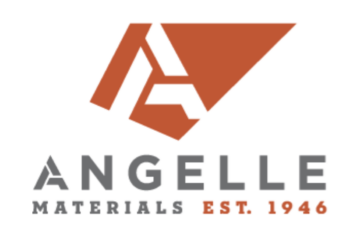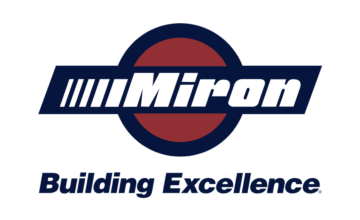abrasion damage—surface deterioration caused by rubbing and friction against the surface.
abrasive—any hard, strong substance, such as rocks, sand, water, or minerals, that will cut, scour, pit, erode, or polish another substance.
abrasive blasting—a process for roughening, cleaning, or finishing a surface by propelling an abrasive medium at high velocity against it; commonly used methods include sandblasting, shotblasting, and high-pressure water blasting.
absorbed moisture—see moisture, absorbed.
absorption—the process by which a liquid is drawn into and tends to fill permeable voids in a porous solid body; also, the increase in mass of a porous solid body resulting from the penetration of a liquid into its permeable voids.
abutment—in bridges, the end structure (usually of concrete) that supports the beams, girders, and deck of the bridge, or combinations thereof, and sometimes retains the earthen bank or supports the end of the approach pavement slab; in prestressing, the structure against which the tendons are stressed in producing pretensioned precast members or post-tensioned pavement; and in dams, the side of the gorge or bank of the stream against which a dam abuts.
accelerated aging—deteriorating a material at a faster-than-normal rate by subjecting the material to specified accelerated test conditions.
accelerating admixture—see admixture, accelerating.
acceleration—increase in velocity or in rate of change, especially the quickening of the natural progress of a process such as setting or strength development (hardening) of concrete. (See also admixture, accelerating.)
accelerator—see admixture, accelerating.
acceptance test—a test conducted to determine whether an individual lot of materials conforms to specifications or to determine the degree of uniformity of the material, or both.
accidental air—see air, entrapped.
acid etching—application of acid to clean or alter a concrete surface; typically used only when no alternative means of surface preparation can be used.
acoustic emission—sounds, both audible and subaudible, that are generated when a material undergoes irreversible changes, such as cracking in concrete; provides the basis for a nondestructive monitoring technique.
acoustic monitoring—a type of nondestructive testing technology whereby transient elastic waves within a material due to localized stress release in a material, or on its surface, are detected and monitored.
acoustic impact—a method used to detect the presence of delaminations or subsurface voids in concrete based on the sounds made by the concrete upon impact. (See also chain drag and sounding.)
acoustic triangularization—identification of the location of an acoustic emission by triangularization from multiple sensors.
acrylic resin—see resin, acrylic.
activator—a material that actuates a catalyst.
active crack—see crack, active.
addition—a material that is interground or blended in limited amounts into a hydraulic cement during manufacture either as a “processing addition” to aid in manufacturing and handling the cement or as a “functional addition” to modify the use properties of the finished product.
functional addition– a material that is interground or blended in limited amounts into a hydraulic cement during manufacture.
air-entraining addition—a functional addition that will entrain air in mortar or concrete.
processing addition—an addition introduced to aid in the manufacture or handling, or both, of a hydraulic cement.
additive—a substance added to another in relatively small amounts to impart or improve desirable properties or suppress undesirable properties; any material other than the basic components of a grout system.
adhesion—the state in which two surfaces are held together through interfacial effects that may consist of molecular forces, interlocking action, or both.
adhesive failure—see failure, adhesive.
adhesives—the group of materials used to cause similar or dissimilar materials to cohere; for example, in concrete work, the epoxy resins.
adiabatic—a condition in which heat neither enters nor leaves a system.
adiabatic curing—see curing, adiabatic.
admixture—a material other than water, aggregates, hydraulic cement, and fiber reinforcement, used as an ingredient of a cementitious mixture to modify its freshly mixed, setting, or hardened properties and that is added to the batch before or during its mixing.
admixture, accelerating—an admixture that (1) increases the rate of hydration of the hydraulic cement and thus shortens the time of setting, increases the rate of strength development, or both; (2) any substance that increases the rate of a chemical reaction.
admixture, air-entraining—an admixture that creates microscopic air bubbles in concrete, mortar, or cement paste during mixing, usually to increase its workability and resistance to freezing and thawing (See also air, entrained)
admixture, alkali-aggregate reaction inhibiting—an admixture that reduces expansion caused by alkali-aggregate reaction.
admixture, antiwashout—an admixture that increases the cohesiveness of concrete to be placed under water, thus inhibiting the amount of fines washed away from the aggregates when the concrete comes in contact with water.
admixture, corrosion inhibiting—an admixture that reduces ingress of chlorides or enhances the passivating layer on the surface of steel reinforcement, or both, thus reducing or preventing corrosion.
admixture, retarding—an admixture that decreases the rate of hydration of hydraulic cement and increases the time of setting.
admixture, shrinkage-reducing—an admixture that reduces drying shrinkage by reducing the surface tension of water in the pore structure of cement paste.
admixture, viscosity modifying—an admixture that can be used to produce self-leveling concrete that remains cohesive without excessive bleeding, segregation, or abnormal retardation.
admixture, water-reducing—an admixture that either increases workability of freshly mixed mortar or concrete without increasing water content or maintains a given workability with a reduced amount of water, the effect being due to factors other than air entrainment.
admixture, water reducing (high-range)—a water-resistant admixture capable of producing large water reduction or great workability without causing undue set retardation or entrainment of air in mortar or concrete.
adsorption—development (at the surface of either a liquid or solid) of a higher concentration of a substance than exists in the bulk of the medium; especially formation of one or more layers of molecules of gases, of dissolved substances, or of liquids at the surface of a solid (such as cement, cement paste, or aggregates), or of air-entraining agents at the air-water interfaces; also the process by which a substance is adsorbed. (See also water, adsorbed.)
advancing-slope grouting—see grouting, advancing-slope.
advancing-slope method—see method, advancing-slope.
aerated concrete—see concrete, cellular and concrete, foamed.
afwillite—a mineral with composition 3CaO · 2SiO2· 3H2O occurring naturally in South Africa, Northern Ireland, and California, and artificially in some hydrated portland cement mixtures.
age hardening—the progressive change in the chemical and physical properties of an adhesive leading to embrittlement. (See also aging.)
agent—a general term for a material that may be used either as an addition to cement or an admixture in concrete; for example, an air-entraining agent.
agent, air-entraining—see admixture, air-entraining.
agent, bonding—a substance applied to a suitable substrate to create a bond between it and a succeeding layer.
agent, parting—see agent, release (preferred term).
agent, release—material used to prevent bonding of concrete to a surface. (See also bond breaker and oil, form.)
agent, surface-active—a substance that markedly affects the interfacial or surface tension of solutions when present even in low concentrations.
agent, wetting—a substance capable of lowering the surface tension of liquids, facilitating the wetting of solid surfaces, and permitting the penetration of liquid into the capillaries.
agglomeration—a gathering into a ball or mass.
aggregate—granular material such as sand, gravel, crushed stone, crushed hydraulic-cement concrete, or iron blast-furnace slag which is used with a hydraulic cementing medium or polymer binder to produce either concrete or mortar.
aggregate, angular—aggregate particles that possess well-defined edges formed at the intersection of roughly planar faces.
aggregate, coarse—(1) aggregate predominantly retained on the No. 4 (4.75-mm) sieve; or (2) that portion of an aggregate retained on the No. 4 (4.75-mm) sieve.
aggregate, crusher-run—aggregate that has been mechanically broken and has not been subjected to subsequent screening.
aggregate, dense-graded—aggregates graded to produce low void content and maximum density when compacted. (See also aggregate, well-graded.)
aggregate, fine—aggregate passing the 3⁄8-in. (9.5-mm) sieve and almost entirely passing the No. 4 (4.75-mm) sieve and predominantly retained on the No. 200 (75-μm) sieve; or (2) that portion of an aggregate passing the No. 4 (4.75-mm) sieve and retained on the No. 200 (75-μm) sieve.
aggregate, gap-graded—aggregate graded so that certain intermediate sizes are substantially absent.
aggregate, heavyweight—aggregate of high density, such as barite, magnetite, hematite, limonite, ilmenite, iron, or steel, used in heavyweight concrete.
aggregate, lightweight—aggregate of low density, such as: a) expanded or sintered clay, shale, slate, diatomaceous shale, perlite, vermiculite, or slag; b) natural pumice, scoria, volcanic cinders, tuff, and diatomite; and c) sintered fly ash or industrial cinders, used in lightweight concrete.
aggregate, mineral—aggregate consisting essentially of inorganic nonmetallic rock materials, either natural or crushed and graded.
aggregate, normalweight—aggregate that is neither heavyweight nor lightweight.
aggregate, open-graded—aggregate in which the voids are relatively large when the aggregate is compacted.
aggregate, reactive—aggregate containing substances capable of reacting chemically with the products of solution or hydration of the portland cement in concrete or mortar under ordinary conditions of exposure, resulting in some cases in harmful expansion, cracking, or staining.
aggregate, refractory—aggregate having refractory properties that, when bound together into a conglomerate mass by a matrix, forms a refractory body.
aggregate, single-sized—aggregate in which a major portion of the particles is in a narrow size range.
aggregate, well-graded—aggregate having a particle-size distribution that produces maximum density, that is, minimum void space.
aggregate blending—the process of intermixing two or more aggregates to produce a different set of properties, generally, but not exclusively, to improve grading.
aggregate interlock—the effect of portions of aggregate particles from one side of a joint or crack in concrete protruding into recesses in the other side of the joint or crack so as to transfer load in shear and maintain alignment.
aggregate transparency—discoloration of a concrete surface consisting of darkened areas over coarse aggregate particles immediately below the concrete surface.
aging—the cumulative effects of time on the properties of materials or substances.
agitation—(1)the process of providing motion in mixed concrete just sufficient to prevent segregation or loss of plasticity;or (2) the mixing and homogenization of slurries or finely ground powders by either mechanical means or injection of air. (See also agitator.)
agitator—a device for maintaining plasticity and preventing segregation of mixed grout, mortar, or concrete by shaking or stirring. (See also agitation.)
agitator tank—a vertical, open-top tank equipped with rotation blades used to prevent segregation of mixed grout.
aids, grinding—materials used to expedite the process of grinding by eliminating ball coating, dispersing the finely ground product, or both.
air—
air, entrained—microscopic air bubbles intentionally incorporated in mortar or concrete during mixing; bubbles are typically spherical with a maximum diameter of 1 mm.
air, entrapped—air voids in concrete that are not purposely entrained and that are larger, mainly irregular in shape, and less useful than those of entrained air; and 1 mm or larger in size.
air barrier—the material (liquid or sheet) that controls air leakage into or out of concrete and masonry wall systems.
air blow pipe—air jet used in shotcrete gunning to remove rebound or other loose material from the work area.
air content—the volume of air voids in cement paste, mortar, or concrete, exclusive of pore space in aggregate particles; usually expressed as a percentage of total volume of the paste, mortar, or concrete.
air-entraining admixture—see admixture, air-entraining.
air-entraining hydraulic cement—a hydraulic cement containing an air-entraining addition in such amount as to cause air to be entrained in mortar within specified limits when measured by the prescribed method.
air content—the volume of air voids in cement paste, mortar, or concrete, exclusive of pore space in aggregate particles, usually expressed as a percentage of total volume of the paste, mortar, or concrete.
air entraining—the capability of a material or process to develop a system of microscopic bubbles of air in cement paste, mortar, or concrete during mixing. (See also air entrainment.)
air-entraining agent—see admixture, air-entraining.
air-entraining hydraulic cement—see cement, air-entraining hydraulic.
air entrainment—the deliberate addition of microscopic air bubbles (generally smaller than 1 mm) to concrete or mortar during the mixing. (See also admixture, air-entraining.)
air lift—equipment whereby slurry or dry powder is lifted through pipes by means of compressed air.
air-water jet—a high-velocity jet of air and water mixed at the nozzle, used to clean surfaces or remove deteriorated concrete; water sprayed at pressures less than 5,000 psi (35 MPa) will remove dirt and loose, friable material; water sprayed at pressures between 5,000 and 45,000 psi (35 – 300 MPa) will remove heavy encrustations of dirt and loose, friable material, including deteriorated concrete.
akermanite—a mineral of the melilite group, Ca2MgSi2O7. (See also gehlenite, melilite, and merwinite.)
alabaster—a compact, crystalline, weakly textured form of practically pure gypsum.
alignment wire—see ground wire.
alite—a name used to identify tricalcium silicate, including small amounts of MgO, Al2O3, Fe2O3, and other oxides; a principal constituent of portland-cement clinker. (See also celite, and felite.)
alkali—salts of alkali metals, specifically sodium and potassium, occurring in constituents of concrete and mortar; usually expressed in chemical analyses as the oxides Na20 and K20. (See also cement, low-alkali)
alkyl aryl sulfonate—synthetic detergent used to entrain air in hydraulic cement mixtures.
alligator cracks—see cracks, alligator.
allowable bearing capacity—the maximum pressure to which a soil or other material should be subjected to guard against shear failure or excessive settlement.
allowable load—see load, service dead and load, service live.
allowable stress—see stress, allowable.
alternate-lane construction—see construction, alternate-lane.
alumina—aluminum oxide (Al2O3).
aluminate cement—see cement, calcium-aluminate.
aluminate concrete—see concrete, aluminate.
aluminous cement—see cement, calcium-aluminate.
ambient—surrounding natural conditions or environment in a given place and time.
amount of mixing—the extent of mixer action employed in combining the ingredients for either concrete or mortar; in the case of stationary mixers, the mixing time; and in the case of truck mixers, the number of revolutions of the drum at mixing speed after the intermingling of the cement with water and aggregates. (See also mixing time.)
amplitude—the maximum displacement from the mean position in connection with vibration.
analysis, dynamic—analysis of stresses in framing as functions of displacement under transient loading.
analysis, mechanical—the process of determining particle-size distribution of an aggregate. (See also analysis, sieve.)
analysis, sieve—particle-size distribution; usually expressed as the mass percentage retained upon each of a series of standard sieves of decreasing size and the percentage passed by the sieve of finest size. (See also grading.)
anchor—a metal bolt, stud, threaded rod, or reinforcing steel, either cast in place, grouted in place, or drilled into hardened concrete, used to prevent dislodging of repairs from concrete substrate in the event of a bond failure; to hold various structural members or embedments in the concrete; and to resist shear, tension, and vibration loadings.
anchor, bonded—a post-installed anchor installed in holes drilled into the concrete substrate and embedded with portland cement grout or polymer materials such as polyesters, vinylesters, or epoxies.
anchor, embedment depth—distance from the member surface to the installed end of the anchor prior to the setting of the anchor.
anchor, expansion—a post-installed anchor designed to be inserted into a predrilled hole and then expanded by tightening a nut, hammering the anchor, or expanding into an undercut in the concrete.
anchor, form—device used to secure formwork to previously placed concrete of adequate strength; the device is normally embedded in the concrete during placement.
anchor bolt—see bolt, anchor.
anchorage—in post-tensioning, a device used to anchor the tendon to the concrete member; in pretensioning, a device used to maintain the elongation of a tendon during the time interval between stressing and release; in precastconcrete construction, the devices for attaching precast units to the building frame; and in slab or wall construction, the device used to anchor the slab or wall to the foundation, rock, or adjacent structure.
anchorage, dead-end—the anchorage at that end of a tendon that is opposite the jacking end.
anchorage, end— (1) length of reinforcement, mechanical anchor, hook, or combination thereof, beyond the point of nominal zero stress in the reinforcement of cast-in-place concrete; and (2) mechanical device for transmitting prestressing force to the concrete in a post-tensioned member. (See also anchorage.)
anchorage, mechanical—any mechanical device capable of developing the strength of the reinforcement without damage to the concrete.
anchorage, threaded—an anchorage device that is provided with threads to facilitate attaching the jacking device and to effect the anchorage.
anchorage, wedge—a device for anchoring a tendon by wedging.
anchorage bond stress—see stress, anchorage bond.
anchorage deformation—see deformation, anchorage or slip.
anchorage device—see anchorage (preferred term).
anchorage loss—see deformation, anchorage.
anchorage slip—see deformation, anchorage or slip.
anchorage zone—see zone, anchorage.
angle float—see float, angle.
angle of repose—the angle between the horizontal and the natural slope of loose material below which the material will not slide.
angular aggregate—see aggregate, angular.
anhydrite—a mineral, anhydrous calcium sulfate (CaSO4); gypsum from which the water of crystallization has been removed, usually by heating above 325 F (160 C); natural anhydrite is less reactive than that obtained by calcinations of gypsum.
anhydrous calcium chloride—see calcium chloride, anhydrous.
anisotropic—exhibiting different physical properties in different directions.
anode—the electrode in electrolysis at which negative ions are discharged, positive ions are formed, or other oxidizing reactions occur.
anode, sacrificial—chemically active metals such as zinc, aluminum, and magnesium which, when electrically connected to the reinforcing bar, will provide the energy needed to cathodically protect the reinforcing bar; sacrificial anodes deteriorate in service at a rate proportional to the energy needed to protect the reinforcing bar plus whatever may deteriorate by local-action corrosion.
anodic inhibitor—an inhibitor that reduces the corrosion rate by acting on the anodic (oxidation) reaction.
anodic protection—a technique to reduce the corrosion rate of a metal by polarizing it into its passive region where dissolution rates are low.
anodic reaction—corrosion reaction involving dissolution of metal into metal ions with the corresponding release of electrons; also sometimes referred to as oxidation.
anodic ring effect—corrosion process in which the steel reinforcement in concrete surrounding a repair area begins to corrode preferentially to reinforcement in the newly repaired area (sometimes referred to as the halo effect).
anticoagulant—a substance which prevents the coagulation of a colloid suspension or emulsion; also called a stabilizer and latex preservative.
antifoaming agent—an additive used to increase surface tension and reduce foaming tendencies, particularly in admixtures and materials applied by roller coating equipment.
antiwashout admixture—see admixture, antiwashout.
apparent specific gravity—see specific gravity, absolute.
application life—the period of time during which a material, after being mixed with a catalyst or exposed to the atmosphere, remains suitable for application.
application rate—the quantity (mass, volume, or thickness) of material applied per unit area.
aramid—a manufactured fiber in which the fiber-forming substance is a long-chain synthetic aromatic polyamide in which is at least 85% amide linkages are attached directly to two aromatic rings.
architect-engineer or engineer-architect—the architect, engineer, architectural firm, engineering firm, or architectural and engineering firm issuing project drawings and specifications, or administering the work under contract specifications and drawings, or both.
architectural concrete—see concrete, architectural.
arc spectrography—spectrographic identification of elements in a sample of material heated to volatilization in an electric arc or spark.
area of steel—the cross-sectional area of the steel reinforcement. (See also effective area of reinforcement.)
arenaceous—composed primarily of sand; sandy.
argillaceous—composed primarily of clay or shale; clayey.
arris—the ridge formed by the meeting of two surfaces.
arrissing tool—see tool, arrissing.
articulated joint—see joint, articulated.
artificial pozzolan—see pozzolan, artificial.
asbestos-cement products—products manufactured from rigid material composed essentially of asbestos fiber and portland cement.
ashlar—see masonry, ashlar.
aspect ratio—the ratio of length to diameter of a fiber.
asphalt—a dark brown to black cementitious material in which the predominating constituents are bitumens that occur in nature or are obtained in petroleum processing.
asphalt cement—see cement, asphalt.
asphaltic concrete—see concrete, asphaltic.
atmospheric-pressure steam curing—see curing, atmospheric-pressure steam.
Atterberg limits—see limits, Atterberg.
Atterberg test—see test, Atterberg.
autoclave—a pressure vessel in which an environment of steam at high pressure may be produced; used in the curing of concrete products and in the testing of hydraulic cement.
autoclave curing—see curing, autoclave.
autoclave cycle—see cycle, autoclave.
autoclaved—see curing, autoclave.
autoclaving—see curing, autoclave.
autogenous healing—a natural process of filling and sealing cracks in concrete or mortar when kept damp.
axis, neutral—a line in the plane of a structural member subject to bending where the longitudinal stress is zero.





